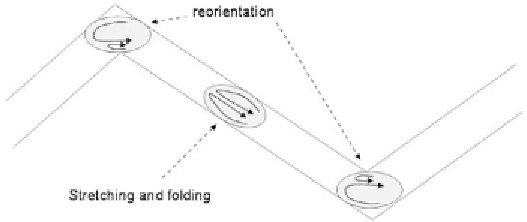Biomedical Engineering Reference
In-Depth Information
Figure 4.62
(a) Internal motion in a moving plug; (b) striation pattern in a moving plug. (c) Once
diffusion has homogenized the two halves of the plug, the mixing is not complete.
where
L
is the length of the plug and
d
the distance traveled by the droplet. Each
time the plug has traveled a distance
d
= 2
L
, the striation thickness is divided
by two. Striation patterns are schematically shown in Figure 4.62(b). The two
halves homogenize first due to the reduction of the striation. Taking into account
that
s
i
(0) »
a
and using (4.90), the time for homogenization of each 1/2 plug is
approximately
2
2
a L
t
»
(4.91)
2
2
D
d
However, at this time the concentration in the plug is not uniform and the situ-
ation is schematized in Figure 4.62(c).
It has been observed that winding microchannels reduce homogenization time
[68]. We analyze here the role of the turns of the capillary tube. Suppose a capillary
tube constituted of
n
linear segments of length
d
~ 2
L
, the segments being individu-
alized by sufficiently pronounced turns. First, the recirculation flow inside the plug
is modified by the turns, as shown in Figure 4.63.
Second, the dissymmetry of the recirculation flow in the turns induces a reorien-
tation of the fluid domains as shown in Figure 4.64. This reorientation is essential
for the mixing of liquids in the plug. This phenomenon is called the Baker's trans-
form and is schematized in Figure 4.65. Reorientation is necessary to increase the
number of striations. Using Ottino's formula (4.89), the striation thickness is
s
t
(
n
)
=
a s
-
n
; using (4.90) with
d
~ 2
L
, we find
s
= 2. The diffusion time at step
n
is then
derived from (4.91)
Figure 4.63
Dissymmetry of internal recirculation flow is induced by turns of the capillary tube.








